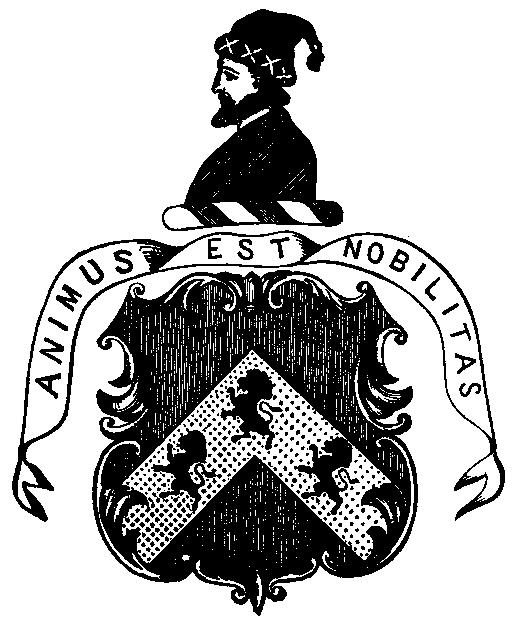Husband [Ancestor] Cobham
Born:
Christened:
Died:
Buried:
Marriage:

• Coat of Arms: Cobham.
Wife
Born:
Christened:
Died:
Buried:
Children
1 M Elijah Cobham 1 2
Born:
Christened:
Died: 3 May 1811 - Wales 2 3
Buried:
Spouse: Elizabeth Hargreaves ( - ) 2 3
Marr: 17 Jun 1792 3
General Notes: Husband - [Ancestor] Cobham
This is a very ancient family, tracing its origin to that Norman ancestor who crossed over to England with William the Conqueror and was rewarded for his services by a title and grant of lands. The long succession of barons that followed became distinguished in the wars with France and in the Crusades; Henricus de Cobham, a Crusader and follower of Richard Coeur de Lion, winning in the Holy Wars his crest, a saracen's head, and the cap of maintenance. During the invasion of France under Edward the Third, it was to a Lord Cobham that the care of the Black Prince was confided at the battle of Crecy; and the long line of distinguished barons and wealthy merchants includes that celebrated martyr and leader of the Lollards, Sir John Oldcastle, who suffered for conscience's sake during the reign of Henry the Fifth. He acquired the title of Lord Cobham through his marriage to Joan, heiress of the line, and in right of his wife held his seat in the House of Peers. From an old work we quote the following: "In the county of Kent, four miles from the city of Rochester, is the pretty town of Cowling, the chief attraction of which is its ruined castle. In the feudal days of England this was one of the strongest of all the baronial holds of the kingdom; it had been for many generations the seat of the noble and powerful house of Cobham. During the early part of the reign of Henry the Fifth it was held by Sir John Oldcastle who had married Joan, heiress of the line of Cobham." Lord Cobham distinguished himself by many feats of arms as a follower of Henry the Fourth, before and after his accession to the throne; and suffered an ignominious death under the fifth Henry, in support of his religious and political convictions. Adopting the views of the great reformer, Wickliffe, he assisted him in the publication of his Bible and lent powerful protection to the early protestants; but when Henry the Fifth ascended the throne the papal influence became too powerful; and after an unsuccessful attempt by the king to win Lord Cobham back to the Catholic fold, he was surrendered to the Archbishop of Canterbury, primate of England. Being incarcerated in the Tower, he made his escape; but was ultimately hanged and his body burned at St. Giles Field, in the year 1418 A. D.
After the martyrdom of Lord Cobham the family retired to the parish of St. Werburge in Sloo, where they resided for many years and subsequently to Jamaica, one of the West Indies, where they became large landed proprietors.
Continuing the line we come to Elijah Cobham, who was a large landowner and slave holder in the West Indies, where he died subsequent to the year 1696. In this year his son, Elijah, was born; who likewise became an extensive land and slave owner in Jamaica, being in possession of the Pucie Hall Estate. He returned to England and there married Ellen Woodcock, of Euxtonburg, near Preston; dying in Liverpool, England, in July, 1767, and leaving a son, John Cobham.
John Cobham, this son, became a merchant of Liverpool and succeeded to the ownership of the property in Jamaica. He married Susannah Ashwarth de Fearns, May 5, 1746, and they lived in a mansion in Castle Street, Liverpool, where he died, leaving a son, Elijah Cobham.
Elijah Cobham, son of John Cobham, also became a wealthy merchant of Liverpool and succeeded to the ownership of the Pucie Hall Estate in Jamaica, where he had many slaves and sugar refineries. His handsome residence in Liverpool was later included in the town as government property and was occupied as barracks for a regiment of cavalry; the property, covering about one acre, was surrounded by a high wall and was situated on a high elevation of land. Mr. Cobham sent out to Jamaica as his supercargo, Jonas Bold, who was a son of the mayor of Liverpool at that time; proving unfaithful to the trust reposed in him, this man sold every cargo which he received and converted the proceeds to his own use, his father having been supposed to be in collusion with him. Jonas Bold was confined in the Flint Street prison for many years, but no restitution was ever made to Mr. Cobham.
The high standing which Mr. Cobham occupied in England and his position in the world are shown by the fact that for a period of six weeks he entertained the Duke of Clarence and his suite at the Pucie Hall Estate in Jamaica; the Duke, then in the navy, afterwards became William the Fourth of England. In 1776 and 1777, French privateers captured Mr. Cobham's ships; which, combined with the losses incurred through Jonas Bold, so reduced his fortune that he retired from business to St. Asaph's in Wales, where he died.